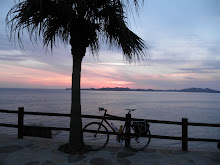| 2. Wash hands and clean your mouth in water, which is always located near the entrance to the temple area. |  |
| 4. Proceed to the Hondo (main shrine) |  |
| 6. Osaisen (coins) should be dropped in a box in front of the shrine. Senko (incense stick) as well as a candle should be lit in memory of your ancestors. |  |
| 7. Chant the Hannya-shingyo (heart sutra) once. |  |
8. Recite the mantra/shingon of the main deity of the temple 7 times.
9. Recite the Komyo-shingon sutra 3 times.
10. Kigan and eko prayers. (Kigan menas prayer, eko is to "transfer merit to all beings")
| 11. Head to the Daishido shrine, (enshrines an image of Kobo Daishi) |
|
13. Chant the Hannya-Shingyo sutra once.
14. Chant the Gohogo Mantra at least 21 times.
15. Kigan (the concluding prayer to invoke the power of deity and extend it to all beings)
16. Chant a goeika. (A buddhist hymn which consists of several stanzas. Each temple has different kinds of verses admiring its deity (Honzon), praising the power of the deity and adoring the nature of the temple. It is chanted with a small bell and stick.)
| 17. Leave for the temple office and ask ask for the seal in your nokyocho. |
|
So how much of all this did I manage? Well, I made sure I at least bowed on entering and leaving, washed my hands, lit an incense stick and after I read the guide book I started to leave an osame fuda at each temple. I would have a prayer or thought at each temple, and get my nokyocho stamped, but as for reciting any mantras or sutras, I passed on this. And as reciting mantras is about THE most important part of shingon buddhism, I was missing a large part of the pilgrim experience here.
So maybe my 88 sins have not all been cleansed yet....









Hi
ReplyDeletethanks for this information - as a non-buddhist planning to visit Shikoku in May 2011, I would also like to be able show respect when entering these religious sites without causing offence and this information has given me some direction.
thank you again.
Chris